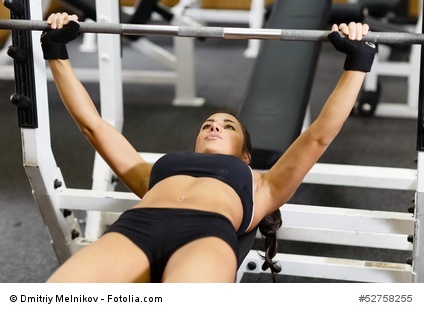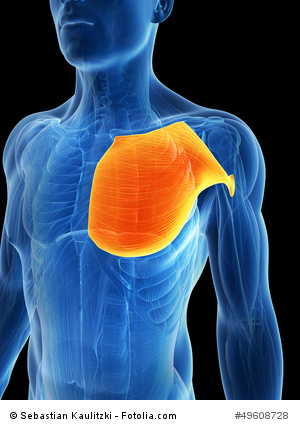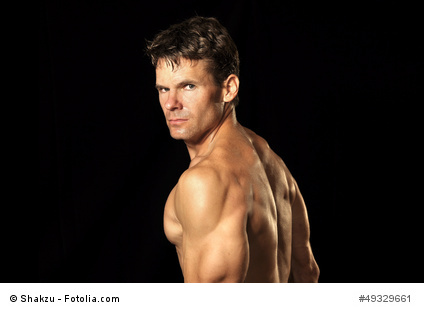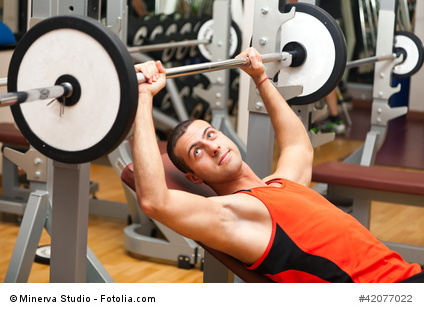Bench Press Technique, In Depth
“Forget bench press technique you Form Policeman! Hey bro! How much you bench?” That is a common question that I hear all the time. Perhaps subconsciously we associate how much we can bench press with how manly we are. All men I talk to want to bench press a boat-load of weight and want to have a chiseled chest that makes everyone’s eyes gaze upon him with awe and wonder. If you are a guy reading this, perhaps you already are bench pressing and if so, good for you! Reading this post will take you to the next level!
“Yo sis! How much you bench?” That is a question that I hear, well…..about never! I’ve been going to the gym for many years, 13 years actually, which is half of my life. Incredibly, I can count the number of women during all that time I have seen bench pressing on 2 hands. Women seem to have a complete aversion to bench pressing, perhaps having the false notion that if they do it they will get a big manly gorilla chest (women have too little testosterone to develop the big bulky muscles that men get).
Women should in fact be running towards the bench press and embracing it like it is a giant chocolate wedding cake. Not only on average are women 40% weaker than men on upper body strength, but not focusing on your chest while working out other upper body muscles will lead to muscle imbalances and injury over time, not to mention a disproportionate and non-aesthetically pleasing look if your arms are muscular but your chest is bony and stringy.
So get going on that bench press ladies! This post will show you what you need to do to get started and teach you more than the majority of people out there know.

Basically, no matter what gender you are, if you want to target and sculpt your chest, the bench press is an essential exercise to integrate into your routine.
So now that you know you should bench press, here is an overview of what will be covered in this blog post:
Overview of what will be covered related to the Bench Press Exercise:
- Proper bench press technique and form
- Muscles worked out during the bench press
- How to maximally target the main muscles doing different bench press variations
- Differences the bench position (incline, decline, flat) have on yourself
- The differences that your grip makes on the bench press
- Safety concerns of the bench press
- How verbal encouragement can help you bench press
- Concluding points
SO LET’S BEGIN!
Proper Bench Press Technique & Form:
First thing’s first, let us go over proper bench press form. Form is essential to prevent injuries, as if proper technique is not established and more weight is added doing improper form, an injury will result eventually. I will be covering the flat bench press form since that version is the most useful. The information I am giving you is being directly taken out of my “Essentials of Strength and Conditioning” book and paraphrased.
Beginning Bench Press Technique Position:
- Lay down on a bench on your back. Make sure your body is fully contacted in 5 places for maximum support and stability. The 5 places you should have support are your head and neck, lower back, upper back and both feet, which should be flat on the ground and not up in the air like I see some people in my gym doing!
- Position yourself below the bar so that you can comfortably lift it off the supports.
- Use a closed grip that is pronated (palms down) when grasping the bar. This is the grip that is not only suggested by the book but that I personally feel is the safest. You DO NOT want the bar slipping from your grip and falling on you.
- Your grip should be slightly greater than your shoulder width.
- From here, you can lift the bar off the rack with your elbows extended fully (Note: the book says to fully extend, but I think they are referring to more power-lifting competition form. Personally, I extend fully doing low to moderate weight I can easily control. I wouldn’t extend fully on heavy weight as you could potentially hyper-extend your elbow. If you have elbow joint problems I’d probably stay away from extending fully altogether). From here is your beginning position.
Going Down With The Bar:
- Here when you are lowering the bar, lower it so it is about at your nipple level. Have the bar touch the chest, no going halfway! You will NOT get the full benefit of this exercise if you only bring the bar down halfway.
- Still hold your 5 point contact position so as to maintain maximum support and stability.
- Keep your wrists directly above your elbows and have them rigid while coming down with the bar.
Going Up With The Bar:
- Continue to have your wrists in a solid position above your elbows.
- Push the bar up until you are back at your starting position.
- Continually maintain your 5-point contact position
- DO NOT arch your back while coming up with the bar. This is a good way to injure yourself.
So now that we got our bench press technique down, let’s go into the muscles involved with benching and when they are activated.
Muscles Worked Out During The Bench Press:

There are many muscles recruited while bench pressing, which I will list. However, I am mainly going to discuss the primary muscles involved which are talked about in the article by Barnett et al. titled “Effects of Variations of the Bench Press Exercise on the EMG Activity of Five Shoulder Muscles.”
Primary Muscles Recruited for the Bench Press:
- Pectoralis Major (Both the Sternal and Clavicular heads of it). The Clavicular head is typically referred to as your upper chest fibers, while the Sternal head is typically referred to as your lower chest fibers.
- Anterior Deltoids (this muscle is at the front of your shoulder).
- Triceps (this muscle is behind your upper arm).
Stabilizing and other Secondary muscles Recruited for the Bench Press:
- Core muscles to stabilize your body
- Rotator cuff muscles to stabilize the shoulder.
- Shoulder blade stabilizer muscles such as Serratus Anterior, lower traps, middle traps, upper traps.
How to maximally target the prime moving muscles of the Bench Press:
The Sternal Head of Pectoralis Major:

Description of Sternal Head of Pectoralis Major and its Actions:
The picture above shows the whole chest just to give you a picture of where it originates and inserts on. The sternal head of the pectoralis major (lower chest fibers) is the biggest part of the chest and originates on the sternum (breastbone that protects heart and lungs) and 1st 6 ribs, then attaches to the upper part of the humerus (upper arm bone). It functions to extend your arm backwards and bring your arm across your body as well as rotate your arm inward.
Bench Press Technique to maximally target the Sternal Head:
Many people say that to best target the Sternal Head of your chest, you should do decline bench presses. According to Barnett et al., the flat bench is better than the decline bench for development of the Sternal Head of the chest. According to a table on the research report, the most activity of the Sternal Head comes from doing the bench press on a flat bench with wide hand spacing. Although, a narrow hand spacing is quite close in activity levels.
Supposedly doing the decline bench press allows more recruitment from the lats to help and there is also less shoulder motion. This is why doing the flat bench is better.
The Clavicular Head of the Pectoralis Major:
Description of the Clavicular Head of the Pectoralis Major and its Actions:
The Clavicular head (upper chest fibers) of your Pectoralis Major muscle starts in the middle half of your clavicle (collarbone) and attaches at the same place your Sternal Head attaches to, the bicipital groove of the Humerus, or upper arm bone. It functions to flex your arm upwards and bring your arm across your body, as well as rotate your arm inward.
Bench Press Technique to maximally target the Clavicular Head:
According to Table 2 in Barnett et al., the Clavicular Head is best targeted on the incline bench with a more narrow grip. However, the incline bench produces very little, if not insignificantly greater activity of the Clavicular Head of the Pectoralis Major as opposed to the flat bench. So doing the flat bench and incline bench are both optimal for focusing on the Clavicular Head of the chest.
The Anterior Deltoids:

Description of the Anterior Deltoid and its Actions:
The anterior deltoid starts from the outer third of your clavicle (collarbone) and attaches to the deltoid tuberosity (that big muscle mass on the top of his arm where it starts to narrow as it goes down the arm). Its actions are flexing your arm upwards, bringing your arm sideways away from your body, and rotating your arm inward. It can also assist your pectoralis major in bringing your arm across your body.
Bench Press Technique to maximally target the Anterior Deltoid:
Sitting down and having your back up against a vertical bench and lifting weight up over your head from this position is an excellent way to hit your anterior deltoids according to Barnett et al. Doing a military press from this position will work out the anterior deltoid muscles the most. Be sure not to lean back while you do this exercise as you will involve the clavicular part of your pecs more.
The Triceps:

Description of the Triceps and its Actions:
The triceps has three heads to it, the lateral, medial and long heads. The long head attaches to the shoulder blade itself and comes down the elbow where it attaches to the Olecranon (curved bony prominence behind the elbow) on the Ulna (a forearm bone). The other 2 heads start a little further down the upper arm but attach at the same place. The actions of the medial and lateral heads are to extend the elbow out straight in front of you. The long head head also is involved in bringing your arm backwards as well as towards your body.
Bench Press Technique to maximally target the Triceps:
According to Barnett et al., the triceps are best worked out on a flat bench with a narrow grip. Narrower hand spacing gives your elbows greater motion than wider hand spacing, thus allowing greater action at the triceps.
How the Position of the Bench Effects You:
For this section, I am getting a lot of my info from Barnett et al. and paraphrasing.
The Decline Bench:
- Clavicular Head of the Pec Major is less active.
- Lats turn on the most during the decline (but still not much activity overall), perhaps explaining why the Sternal Head of your Pecs is not maximally activated as opposed to the flat bench.
- Activity of the Anterior Deltoid muscle was the least with the decline bench.
The Flat Bench:
- Sternal Head of the Pec Major is most active here.
- The Clavicular Head of the Pec Major is very slightly less active with the flat bench than the incline bench.
- The flat bench is the most effective position for hitting the triceps.
The Incline Bench:
- Triceps not as active here compared to the flat bench and decline bench.
- Clavicular Head of the Pec Major is very slightly more active here than on the flat bench.
- The Anterior Deltoid muscle is more active here.

The Vertical Bench:
- Sternal Head of the Pec Major has very low activity.
- The Clavicular Head of the Pec Major has its lowest activity here of all the positions.
- The Anterior Deltoid muscle is the most active here.
The Differences that your Grip makes on the Bench Press:
I got more information here from Barnett et al. as well as an article from Gregory J. Lehman which I will talk about further.
- A narrower grip with palms down on the bar is shown to generate greater activation of the triceps and clavicular head of your pectoralis major.
- A palms up grip is shown to generate increased activity of the biceps muscle according to Gregory J. Lehman in the article “The Influence Of Grip Width And Forearm Pronation/Supination On Upper-Body Myoelectric Activity During The Flat Bench Press.”
- According to the information above, a narrow grip width works the triceps more, however, the Sternal Head of the Pectoralis Major works less. If you wanted to boost the Sternal Head activity and keep the Triceps activity at the same time, gripping the bar in a palms up grip is the bench press technique to use.
- According to Barnett et al., a wide grip on the flat bench is most effective bench press technique for working out the Sternal Head of your Pectoralis Major. However, the effectiveness is only slightly more than that of a comparatively narrower grip on the flat bench.
Safety Concerns of the Bench Press:

With the bench press exercise and the variations of it, because you are lifting heavy weight above your body, there are obvious safety concerns to take into account to avoid injury, either injuries that develop over time from bad form, or serious traumatic injuries that result in broken bones or even death. I got a lot of my info from this section from an article by Carly M. Green and Paul Comfort titled, “The Affect of Grip Width on Bench Press Performance and Risk of Injury.”
The importance of Proper Form:
Overall Body Form:
- Remember the 5 points of contact position on the bench. Your head, upper back/shoulders, lower back/butt should be in contact with the bench at all times. Having your head off the bench while you lift may strain the muscles in your neck, while arching your back while you lift is a good way to blow out your back and get other serious injuries. Both your feet should be on the floor while you lift to allow you to maintain your balance.
Grip Form and Hand Spacing:
- DO NOT USE A SUICIDE GRIP! This is vital to proper bench press technique. A suicide grip on the bar is when you don’t wrap your thumb around the bar but rather place it in the same direction as your other fingers. This can allow the bar to slip out and if you are lifting heavy weight, this can lead to serious injury or worse!
- According to Carly M. Green and Paul Comfort’s article called “The Affect of Grip Width on Bench Press Performance and Risk of Injury”, your grip width should be no greater than 1.5x shoulder width.
- A grip 1.5x shoulder width or greater can result in several injuries according to the article, including atraumatic osteolysis of the distal clavicle (collarbone), rupturing your pectoralis major chest muscle, or instability at your shoulder, where the head of your humerus (upper arm bone) is unstably held in its place to the shoulder blade.
- The clavicle (collarbone) is a vulnerable area in the body and is especially prone to atraumatic osteolysis and breakdown over a long period of time doing the bench press with a grip 1.5x shoulder width or greater. This is especially exacerbated according to the article when using a wide grip on the incline bench or doing a behind the neck press.
Takeaway on how to Perform the Bench Press with Maximum Safety:
- Use a spotter.
- Use weight you can lower in a slow, controlled manner.
- Bring the weight to the lower part of your chest to decrease sideways motion and rotation at your shoulder to decrease risk of injury. Regarding my bench press technique I personally feel comfortable bringing the weight when I bench to just below the nipple line.
- According to the article, experienced lifters take longer to complete a repetition of the bench press, which results in a decreased force that is placed on the musculo-tendinous junction. This may be a bench press technique you will want to incorporate.
- Interestingly, the article also advises that you should stop doing the incline bench press unless the angle of the incline is needed for a sport you are performing. The angle of the incline is externally rotating your arm more, increasing your risk of injury. In the earlier article I mentioned by Barnett et al., titled “Effects of Variations of the Bench Press Exercise on the EMG Activity of Five Shoulder Muscles”, the upper part of your chest, or clavicular head, is activated to a very small extent more on an incline than a flat bench. The difference is so small in fact that it is practically negligible.
- Narrower grips reduce the stretch on the inferior fibers of the Pectoralis Major, which are vulnerable to injury due to their twisting orientation as they attach to your humerus, or upper arm bone.
- Use a lower weight if you are going to try to bench press differently based on the suggestions given. Your body will need some time to acclimate to the new form you are using.
- Inhale on the way down with the bar and exhale on the way up. WARNING: Breathing against a closed airway will cause you to do the Valsalva Maneuver, which can skyrocket your blood pressure and lead to dizziness, passing out, or even worse things to occur.
The Positive Effects of Verbal Encouragement on the Bench Press

Too often in the gym, I see spotters just standing there like a Scarecrow not saying anything to the person who is lifting. I recently read an article by James B. Wise et al. titled “Verbal Messages Strengthen Bench Press Efficacy.” The overall premise of the article is that self-efficacy is important to lifting and the study looked at how to increase lifter’s self-efficacy. The study was done specifically on women, but it would make perfect sense to me that it would apply to men as well.
What is Self-Efficacy?
- According to the article, self-efficacy is the confidence people have in their ability to accomplish specified levels of achievement.
- According to the article there are 4 things that elevate self-efficacy, including:
- Performance of a task successfully.
- Observing someone else perform the task successfully.
- Positive encouragement from one who is seen as a credible source.
- Receiving an indication of readiness from interpretation of physiological signals.
How one can raise someone’s Self-Efficacy while they bench press:
- Present yourself as a credible source of information so that the person lifting believes in you and what you are saying. This was done in the study being performed and increased the amount of weight the subjects lifted. Even if you have no certifications, after reading this in depth article on bench pressing, you will be very well versed in proper technique and can therefore voice your confidence to them and have them believe in you, increasing their self-efficacy.
- Give a specific comment after their set related to what they just did. As in, the weight they lifted, the amount of reps, etc.
- Profess your belief in their ability to lift the weight by saying something along the lines of, “You have the strength to do this exercise.” As simple as that sounds, it does help.
Concluding Points on the Bench Press Exercise:
- The flat bench is overall the most effective exercise with regards to developing the chest.
- The decline bench has no advantages over the flat bench and is less effective in just about every measure.
- The incline bench should be avoided unless your sport or specific activity you are practicing for calls for that inclined angle of movement.
- Grip widths of 1.5x shoulder width or greater should be avoided in your bench press technique to prevent injury.
- Use a pronated grip (palms down) to grasp the bar as I feel that is the safest grip. If you have a shoulder injury or are doing shoulder rehab, a supinated grip (palms up) is better as the biceps are involved more and help to stabilize the shoulder.
- Do NOT use the Suicide Grip where your thumb is not grasping the bar and securing it properly.
- Narrower grips on the bar tend to involve the triceps muscle and Clavicular head of the Pectoralis Major more.
- The Military Press is the best exercise to workout the Anterior Deltoids.
- Verbal encouragement and a stating of your own qualifications should be given to the person you are lifting with to improve their performance.
Works Cited
C. M. Green, P. Comfort. The Affect of Grip Width on Bench Press Performance and Risk of Injury. Strength and Conditioning Journal. 2007; 29(5): 10-14.
C. Barnett et al. Effects of Variations of the Bench Press Exercise on the EMG Activity of Five Shoulder Muscles. Journal of Strength and Conditioning Research. 1995; 9(4): 222-227.
G. J. Lehman. The Influence Of Grip Width And Forearm Pronation/Supination On Upper-Body Myoelectric Activity During The Flat Bench Press. Journal of Strength and Conditioning Research. 2005; 19(3): 587-591.
J. B. Wise et al. Verbal Messages Strengthen Bench Press Efficacy. Journal of Strength and Conditioning Research. 2004; 18(1): 26-29.
T. R. Baechle, R.W. Earle. Essentials of Strength Training and Conditioning. 2nd Edition. The National Strength and Conditioning Association. 2000.
